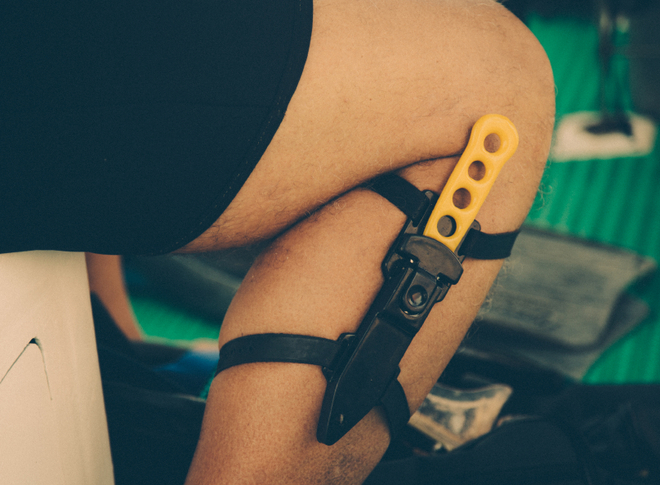Ah, the dive knife. The quintessential piece of dive gear, and probably the most recognizable piece in the diver’s kit, second perhaps only to the dive watch. Take a non-diver to a dive shop and leave them alone for a while, and chances are you’ll find them at the knives or watches section. But why do we even carry knives in the first place? And what makes a good dive knife?
The tradition of the dive knife
We bring dive knives not, as movies would have you believe, to ward off sharks and giant octopuses. Rather, they are tools used primarily to free ourselves in case of entanglement in ropes, lines or aquatic plant life. Essentially, they are part of our safety kit. Also, we can use them between dives to cut lines for securing kit or other tool-oriented tasks. Often, though, knives aren’t absolutely necessary to get out of an entanglement, as we can often untangle ourselves if we move slowly and deliberately and, ideally, have the help of a buddy. Knives are traditionally worn on the calf, where they are attached using rubber straps. This is a tradition that stems back from the commando swimmers and frogmen of World War II.
The modern dive knife
The brave gentlemen of the aquatic war theatre had other concerns than we peacetime divers do, of course. For one, the knives they carried were military-issued combat knives, to be used as weapons as much as tools. Because of that, they were pretty big. And to this day, this design survives, as does the calf mount. But truth be told, large knives aren’t usually necessary for ordinary divers and can often present an entanglement risk of their own. A large, bulky knife on your calf can get stuck on a bit of fishing net pretty easily.
The frogmen of yesteryear wore them that way because it was the only option they had at the time. Today, we have BCDs of varying design, so a more preferable placement of a knife is somewhere attached to the BCD. Either on the waistbelt, attached onto the pocket of the BCD or strapped onto the low-pressure inflator hose. To make this work, a smaller knife is often desirable and fully capable of the tasks we divers put it to. Knives made from modern materials such as titanium are better at warding off rust and also keep their edges better.
The knife alternative
The fascination with dive knives is interesting, especially considering that many experienced divers actually don’t even carry them but opt for trauma shears instead. The angled scissors have several advantages. First, it is highly unlikely that the diver will cut or stab him or herself with trauma shears, whereas this can occasionally happen with knives. Even a small puncture wound can be a big problem if you’re in a dry suit and have suddenly gotten a hole in it, letting water into your suit. Also, shears are easier to use with one hand. To cut a line with a knife you need to keep it taught, so one hand holds the line while the other one cuts. This is often possible, but not always so. Another advantage is that a pair of shears can cut a line that is slack.
What I carry
I actually do have a big old dive knife with a six-inch blade from my days of diving California’s kelp forests. The kelp here is the largest in the world and grows to a size and strength comparable to climbing rope, so diving with something akin to a machete is a good idea (this is one of the few situations where a large knife is in fact called for). I don’t use this knife much anymore, except for freediving and spearfishing.
If I’m diving down on a single breath-hold and get entangled in a fishing line, I want to get free fast so a larger knife with more cutting power is preferable. I can do a three-minute breath-hold, so assuming it’s a 30-second ascent and descent, I’ll have only two minutes to free myself of any entanglement before I have to shoot for the surface. And that’s provided I have the good sense to get myself entangled first thing on the dive. So you better believe I’ll carry a big knife on those trips.
My main knife is a much smaller one, though – a little Halcyon H, with a 2.5-inch titanium blade that’s small enough to fit on my BCD waistbelt, where I can reach it with both hands. This is what I bring on 95 percent of all my scuba dives.
Finally, for areas that don’t allow for dive knives (such as the Red Sea), I’ll bring a pair of trauma shears. Often, I actually carry these in the pocket of my BCD or drysuit even when bringing my Halcyon knife, just as a backup.
But come to think of it, I’ve never actually used any of these knives during a dive. And that’s, of course, a good thing.
Checklist for choosing a dive knife
A good dive knife should…
- Not be overly large – a blade of two or three inches is usually plenty big
- Allow for a good grip on the handle, even with gloves
- Be able to be worn mounted to your BCD, within reach of both hands
- Have a line hook
- Ideally be made out of titanium


